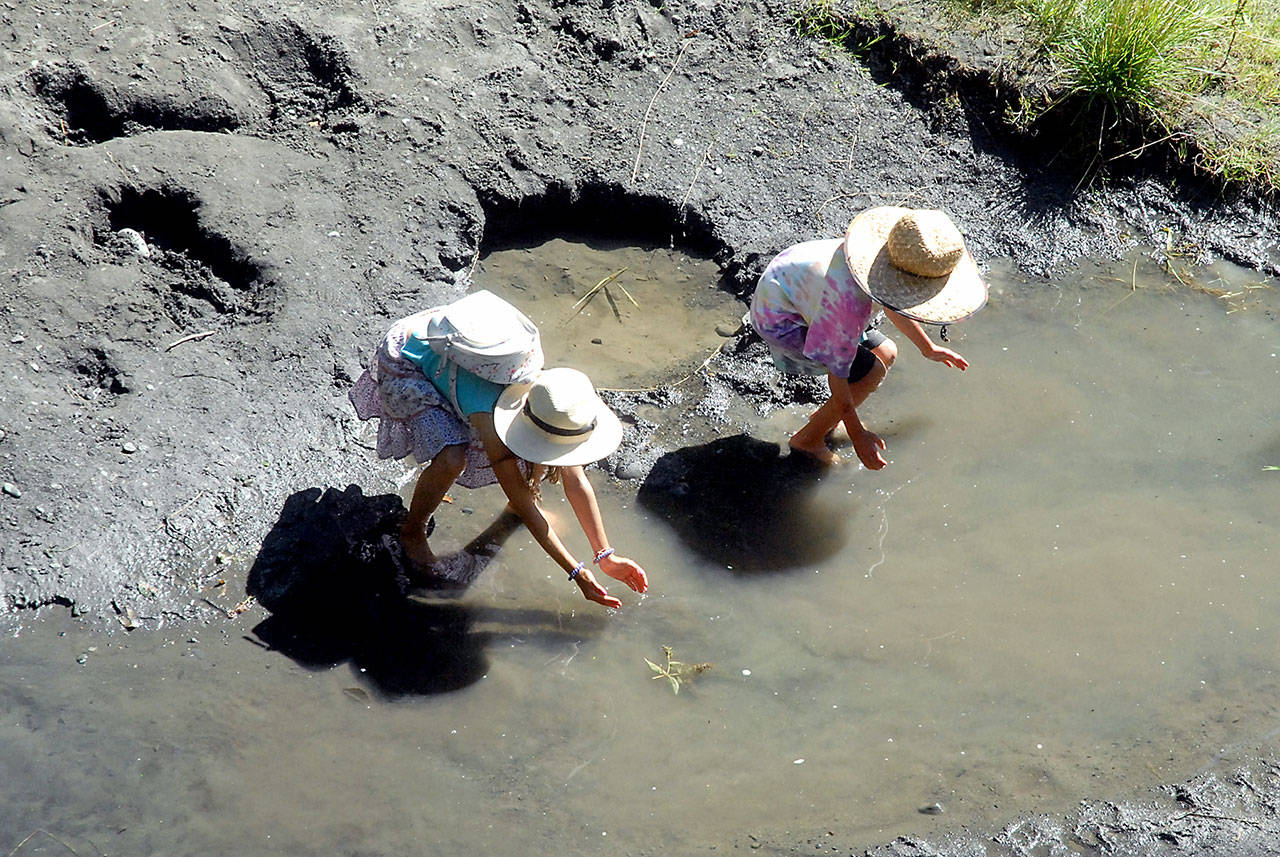Record-level heat in June and weeks without rainfall has once again led to low flows on the Dungeness River prompting a local water users association to declare drought conditions and ask users to restrict some river water usage.
The Dungeness Water Users Association (WUA), group of seven irrigation districts and companies that divert water from the Dungeness River to supply irrigation water throughout the area between Sequim Bay and Siebert Creek, announced last week thy are initiating its drought response program.
“The WUA is asking all their water users to cease any unnecessary uses of irrigation water and where possible, use well water for livestock and essential residential needs,” the organization said in a press release on Aug. 20. “Please consider the needs of our area farmers whose livelihoods depend on irrigation.”
On average, the combined WUA diversions run about 40 cubic feet per second (cfs) during the irrigation season of April 15-Sept. 15. (One cubic foot of water is equal to a little less than 7.5 gallons, and a cubic foot per second is about 7.5 gallons passing by each second)
During the week of Aug. 8-14, flows at the mouth of the Dungeness hit 115 cfs. Irrigators are required to reduce their diversions in order to maintain at least 62 cfs in the river.
Although the river hasn’t reached the low flows that require reduced diversions, flows have been declining rapidly in recent days, association members said. Over the first three weeks of August, the flow at the Dungeness River mouth dropped by nearly half. Just one month ago the flow was more than 300 cfs.
The flow upstream of all diversions on Aug. 20 was 127 cfs. The mean for that day, based on a 92-year record, is 230 cfs. The lowest flow ever recorded on that date was 92.9 cfs in 2015.
According to WUA rules, “In accordance with Washington State law, all members’ water delivery shall be curtailed pro rate in relationship to all other water users during periods of any drought.”
Details on WUA rules, as well as a guide to responsible irrigation, can be found at on the Clallam Conservation District website at clallamcd.org/conservation-on-the-farm.
A strong level of snowpack in the winter and early spring had water users hopeful the drought program would not be initiated, but dry weeks in June, July and August nixed that.
Tips for your yard, garden during a drought
The Dungeness Water Users Association and Clallam County Conservation District offers these suggestions to maintaining Sequim-area yards and gardens during this drought:
1. Forego irrigating the lawn. Turf grass naturally goes dormant in summer, so consider giving in to a golden lawn instead of a lush green lawn. Mow high, 2-and-a-half inches or more, and use a mulching blade. Taller plants equal deeper roots, which means healthier plants. A mulching blade will leave the finely chopped clippings in place to insulate the soil and add water-holding organic matter.
2. Prioritize irrigation needs when things get really dry. Consider what is essential for survival rather than striving for optimum growth. Most well-established plants should be able to survive without any irrigation and many others will get by with a good soaking just once per month through the summer. Turf grass will bounce back fine in the fall if you apply just 1 inch of water for each month without rain.
3. Convert some lawn into a less water-demanding landscape. Instead of struggling to keep that lawn green through the summer, transform it into a carefree bed of drought-tolerant ground covers, shrubs and perennials. You can start by simply covering the lawn with a foot of mulch to kill the grass, then plant in fall or spring. Consider adding deck areas, patios and pathways as alternatives to a thirsty lawn.
4. “Check out the Clallam Conservation District Conservation “Around the House” web page (clallamcd.org/conservation-around-the-house) for our “Water-Wise Plants for Landscaping” fact sheet and other resources about water conservation in the landscape.
5. Mulch around perennials, trees and shrubs. It’s too late for mulch to be of much benefit this year, but after the soil moisture improves in fall, you apply mulch to retain moisture for next summer. Furthermore, mulch inhibits weeds that compete with desirable plants for moisture and nutrients. Mulch is the best insurance you can buy for a healthy landscape.
6. Install a cistern to capture roof runoff water. Again, it is too late for this year, but it’s never too late to start planning for next year. You can use the harvested water to irrigate small garden areas and supply livestock water. Check out the Clallam Conservation District’s “Rainwater Harvesting Basics” publication (available at clallamcd.org/conservation-around-the-house) for more information.



